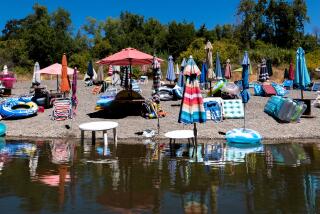1,450-Mile-Long Water Park
- Share via
GRAND LAKE, Colo. — In a wetland meadow high in the Never Summer Range of the Rockies, the Colorado River begins its 1,450-mile journey to the sea.
Snowdrifts 5- to 10-feet deep block the trail head until mid-June, giving hardy hikers, anglers and hunters only a brief window to visit the Colorado’s chill headwaters before snow returns in September.
As snowmelt and stream slowly become river, the Colorado pushes down through the Rockies and becomes something early explorers never imagined: a water-world playground for millions, the cold, clear lubricant for a $1.25-billion-a-year recreation industry that employs fishing guides, white-water rafters and blackjack dealers.
With the popularity and big business have come pollution, politics and pressure.
The beaches of Lake Powell above Glen Canyon Dam close periodically, fouled by human waste. With its 2,000 miles of shoreline, the lake attracts 2.5 million visitors a year--but has only 46 bathrooms and portable toilets to serve them.
On the shores of Lake Mead, near Las Vegas, there are virtually no restrooms to serve the as many as 10,000 people one can find camping there on a summer night.
“I don’t think there’s any question that all that [recreational] use . . . has got to have an impact on water quality,” said Pam Hyde, southwest director of American Rivers, a national river-conservation organization.
“We’re going to have to consider what the recreational uses are doing to the river and factor that into potential changes in uses of the river.”
Over the last 30 years, river recreation has become the lifeblood for such towns as Lake Havasu City and Bullhead City in Arizona and Laughlin, Nev., at the south end of the Lake Mead Recreational Area.
Some 14.2-million visitors a year flow to the recreational crown jewels of the Colorado: Glen Canyon Recreational Area on the Arizona-Utah border, the Grand Canyon’s white-water rapids and Lake Mead and Lake Havasu on the Arizona-California border. They spend an estimated $1.25 billion.
On holiday weekends, there are 50,000 people boating in the Lake Havasu area alone.
“We pretty much claim tourism is our No. 1 industry, and it’s definitely associated with the lake,” said Bonnie Barsness of the Lake Havasu Visitor and Convention Bureau.
“The river is our mainstay. That is it. Period,” said Betty Rowland of the Bullhead Area Chamber of Commerce.
“Starting about now, our river will look like you could walk across it because of all the boats. People come here for a more relaxed atmosphere. They enjoy the lake [Mohave] and river during the day and the 11 casinos at Laughlin in the evening.”
Back at the river’s headwaters, far from the teeming masses, the marshy meadow is ringed with dense spruce and, in brief summer, ablaze with marsh marigolds and other wildflowers. Home to beaver, elk, deer, moose and mountain lion, the Colorado’s source is surrounded by 12,000-foot mountains whose bare granite peaks soar far above timberline.
Even there, the recreational industry is nearby. One of the first is Art and Virginia Krizman’s Timber Rafting Co. in Granby, Colo., 35 miles southwest of the Colorado’s source. Timber Rafting handles about 3,000 tourists a season.
“I was real happy in Arizona retail sales. Then one day, I was asked to go on a Grand Canyon rafting trip. It changed my whole life,” Krizman, 47, recalled. “I found out this is what I wanted to do the rest of my life.”
Their tours run from a day trip at $52 a head, to four-day journeys at $100 a day that cover 65 miles as the river drops 2,000 feet in elevation and passes through two mountain ranges and Gore Canyon.
The rafting business picks up downriver at Glenwood Springs and again at Moab, Utah, near Canyonlands. And this year, the river is roaring with heavy spring runoff.
At Lake Powell, recreational dollars go from a trickle to a torrent.
One survey put the total value of all vessels on Lake Powell at $191 million with an average of more than $100,000 per boat, said Verna Stoddard, business manager of the Lake Powell Yacht Club. Vessels range from 20-foot runabouts to 70-foot, $70,000 houseboats.
The yacht club began with a group of Page, Ariz., residents “who wanted to do things for boaters on Lake Powell to protect our rights. . . . If you don’t have someone representing boaters, you are lost in the system,” Stoddard said.
Stoddard’s yacht club lobbied for more rangers on the lake and supported proposed entrance fees on the condition that those fees stay in the park.
Boating or vehicle entrance fees, new this year, are $5 a day or $10 a week, and 80% of the fees are to be used in the park.
For decades, the recreational potential of the Colorado mattered little to river planners, who were more concerned about flood control, irrigation and hydroelectric power.
But with the West’s population boom, that is changing.
“On water, here in the desert Southwest, we’re hitting the wall first,” said Hyde of the American Rivers group. “I think out here will be the precedent-setting” decisions on river usage.
Already underway is the five-year Lower Colorado Multispecies Conservation Program study of endangered species and their habitat in relation to power, water usage and recreation.
“If one of the [study’s] conclusions is that recreation has a significant impact on certain areas, I think then you may find these recreational interests will feel their ox is being gored,” Hyde said. “These recreational interests may really pull together to bring political pressure to bear. It’s hard to say when or what will mobilize them as a group.”
More to Read
Sign up for The Wild
We’ll help you find the best places to hike, bike and run, as well as the perfect silent spots for meditation and yoga.
You may occasionally receive promotional content from the Los Angeles Times.






